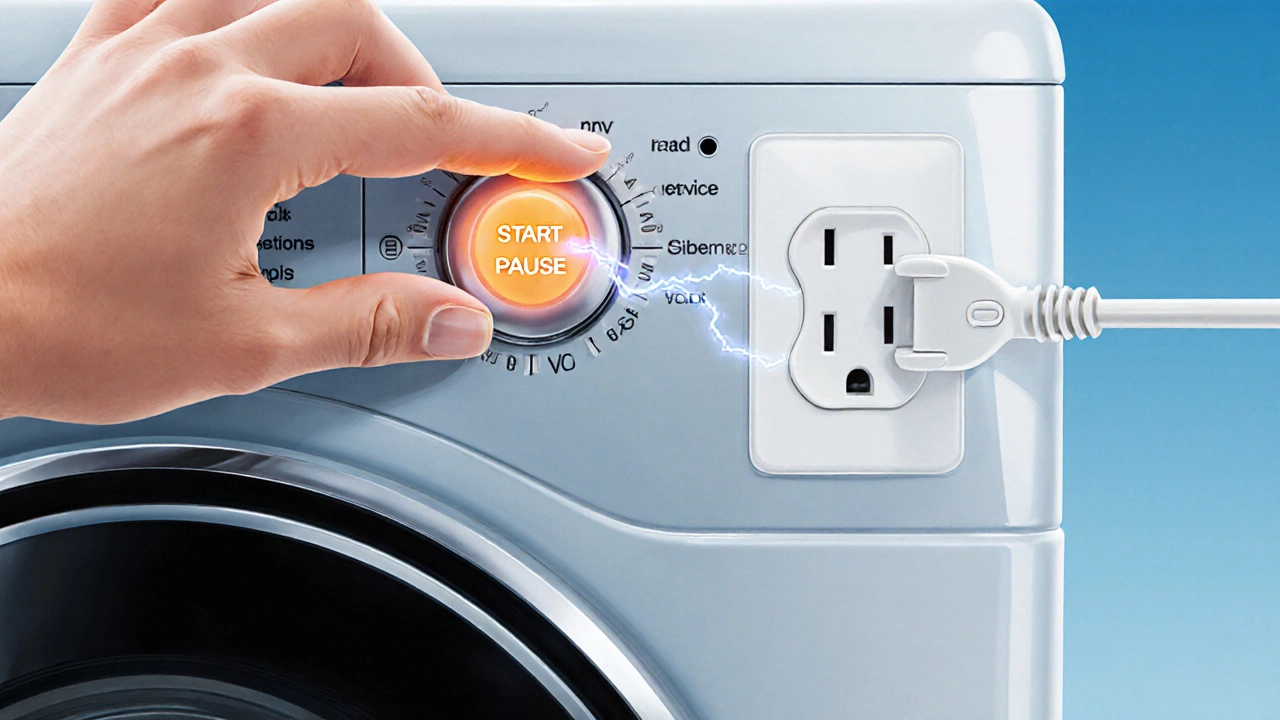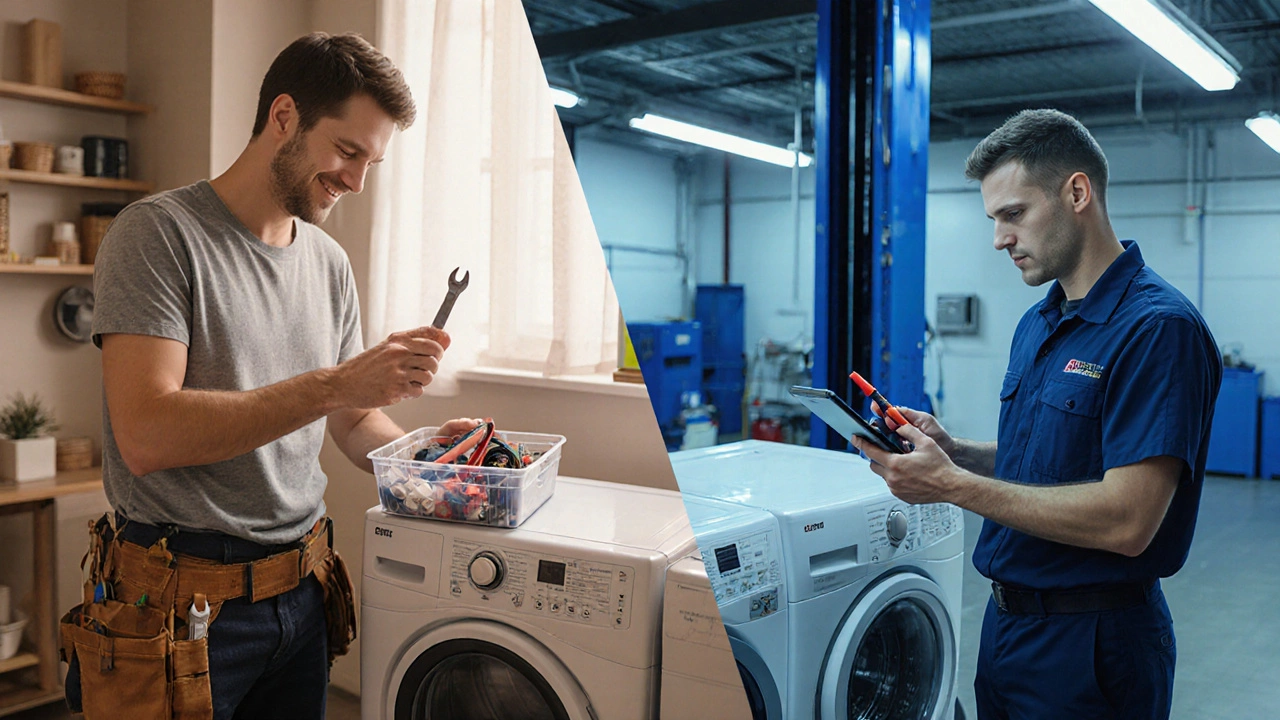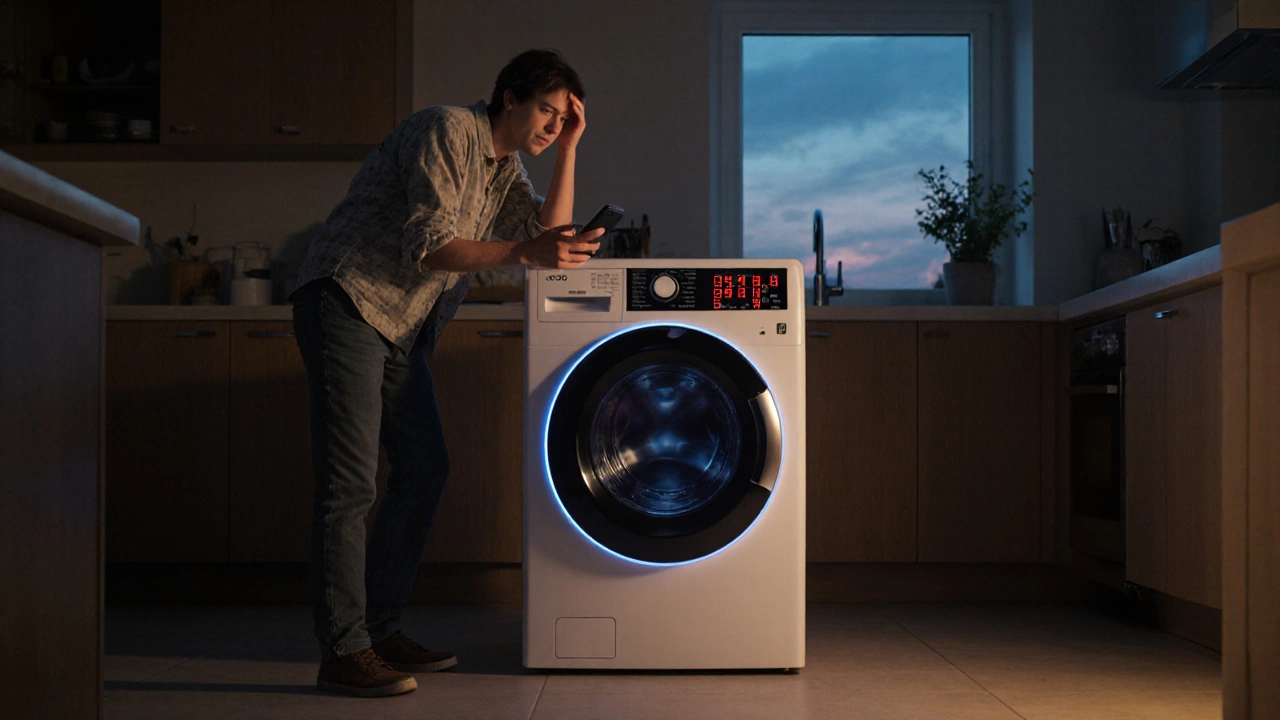Washing Machine Error Code Finder
Find Your Error Code Solution
Enter your washing machine's error code to see what it means and how to fix it.
Select an error code to see recommended reset steps.
When your washing machine starts acting up-spinning forever, flashing lights, or refusing to start-the first thing to try is a reset. A proper washing machine reset can clear error codes, reboot the control board, and often spare you a costly service call.
What a Reset Actually Does
Washing machine is a household appliance that automates the washing of clothes using water, detergent, and mechanical agitation. Inside, a digital control board manages cycles, reads sensor input, and displays error codes runs the show. When something goes wrong-like a door lock sensor failing or a water inlet issue-the board stores an error code. A reset clears that memory, forces the board to re‑initialise, and gives the machine a fresh start.
When to Try a Reset First
- Lights flashing in a pattern (often an error code)
- Machine stops mid‑cycle or won’t start at all
- Unusual noises or vibrations after a recent move
- After a power outage or surge
If none of these symptoms appear, you might be dealing with a mechanical problem that a reset won’t fix.
Soft Reset: Power Cycle the Machine
The simplest reset is a power cycle. It’s safe for any model and takes just a minute.
- Turn the machine off by pressing the power button (if it has one).
- Unplug the appliance from the wall outlet.
- Wait 30-60 seconds. This pause lets the control board discharge residual power and clear temporary memory.
- Plug the machine back in and turn it on.
- Select a short cycle to see if the error clears.
This method works for most non‑persistent faults, such as a momentary sensor glitch.
Hard Reset: Re‑initialise the Control System
Some brands (e.g., Samsung, LG, Bosch) have a built‑in hard‑reset sequence that restores factory defaults.
- Turn the machine off and unplug it.
- Press and hold the Start/Pause button for 5‑10 seconds.
- While still holding, plug the machine back in.
- Continue to hold the button until the display either flashes or shows “0‑0‑0” (or a similar code).
- Release the button. The control board has now cleared all user settings and error logs.
After a hard reset, you’ll need to re‑select your preferred wash settings, but any lingering error codes should disappear.
Factory Reset: When the Manual Doesn’t Help
If a hard reset doesn’t clear the problem, a full factory reset may be required. This is more involved and, for some models, needs a service key or a technician’s code.
- Consult the user manual for the exact key combination (often “Spin + Temp + Start”).
- Turn the machine off and unplug it.
- Press the required buttons simultaneously, then plug the machine back in while keeping them pressed.
- Hold the buttons for 10-15 seconds until the display shows “CL‑R” or “F‑R”.
- Release the buttons; the machine is now restored to out‑of‑the‑box settings.
Factory resets wipe custom cycles and any saved language settings, so use them as a last resort.
Component‑Specific Resets
Sometimes a single component is at fault and can be reset on its own.
- Door lock sensors whether the drum is sealed before water fills: Turn the machine off, wait a minute, then close the door firmly and restart.
- Water inlet valve controls water flow into the drum: Shut off the water supply, inspect the hose for kinks, then restore flow and reset the machine.
- Drain pump removes water after the wash cycle: Clear any blockages, then run a short spin‑drain cycle.
These targeted resets can fix errors like “E1” (door lock) or “E5” (water fill).

Comparison of Reset Methods
| Method | Steps Required | Typical Use‑Case | Time Needed |
|---|---|---|---|
| Soft Reset (Power Cycle) | Unplug → wait 30 s → plug back | Flashing lights, minor glitch | 1 min |
| Hard Reset (Button Hold) | Unplug → hold Start/Pause → plug back → release | Persistent error code, after power surge | 2-3 min |
| Factory Reset | Manual key combo + unplug/plug | Error remains after hard reset, custom settings corrupt | 5-10 min |
| Component Reset | Isolate component, clear blockage, retry cycle | Specific error (door lock, inlet, drain) | Varies (2-5 min) |
Common Error Codes and Their Reset Strategies
Understanding the code you see can save time. Here are a few frequent ones:
- E1 / F01 - Door lock failure. Try a component reset of the door lock, then a soft reset.
- E2 / F02 - Water fill timeout. Check the water inlet valve for blockage or faulty solenoid, then hard reset.
- E3 / F03 - Drain pump error. Clear any lint, run a drain‑only cycle, and perform a soft reset.
- UE - Unbalance detection. Redistribute the load, then run a spin‑only cycle before resetting.
When a code persists after the appropriate reset, it likely signals a hardware fault that needs professional attention.
Safety Tips Before You Reset
- Always disconnect power before inspecting internal parts.
- Make sure the water supply is turned off to avoid leaks.
- Keep the child‑safety lock off if your model has one.
- Consult the user manual for model‑specific instructions; some high‑efficiency units have unique reset combos.
Following these precautions prevents accidental electric shock or water damage.
Step‑by‑Step Troubleshooting Checklist
- Identify the symptom (e.g., flashing lights, no spin).
- Look up the error code on the panel or in the manual.
- Attempt a soft reset.
- If the code remains, try a hard reset.
- For specific component errors, isolate and reset that part.
- Run a short test cycle to verify the issue is resolved.
- If the problem persists, note the code and contact a qualified appliance technician.
This checklist keeps you from jumping straight to a service call and often fixes the issue yourself.
DIY vs. Professional Service
Most resets are safe DIY tasks. However, if you encounter any of the following, call a pro:
- Burning smell or sparks when plugging the machine back in.
- Repeated error codes after multiple reset attempts.
- Leaking water during a reset attempt.
- Complex electrical diagnostics beyond a simple board reboot.
Professional technicians have the tools to test voltage, replace control boards, and handle warranty concerns.

How long does a washing machine reset take?
A soft reset usually takes about a minute. Hard resets can be 2-3 minutes, while a full factory reset may require 5-10 minutes depending on the model.
Can I reset my washing machine without the manual?
Yes. Most manufacturers use a standard power‑cycle or button‑hold method that works across many brands. However, for a factory reset you’ll need the exact key combo, which is typically listed in the manual.
Why does my washer keep flashing the same error code after I reset it?
If the code persists, the underlying component (door lock, inlet valve, drain pump, etc.) likely failed. The reset only clears the memory; the fault needs to be repaired or replaced.
Is it safe to unplug my washer while it’s mid‑cycle?
Unplugging mid‑cycle can cause water to overflow if the drain pump hasn’t finished. If you must stop the cycle, first press the pause button, wait for the drum to stop, then unplug.
Do I need to reset the washing machine after a power outage?
A power outage can leave the control board in an undefined state. Performing a soft reset (unplug → wait → plug back) is recommended before starting a new load.

I am an expert in the services industry with a focus on appliance repair. My passion lies in understanding how things work and educating others in simple, engaging ways. This enthusiasm fuels my writing, where I delve into topics around appliance maintenance and troubleshooting. I aim to make these subjects clear and accessible to all readers.